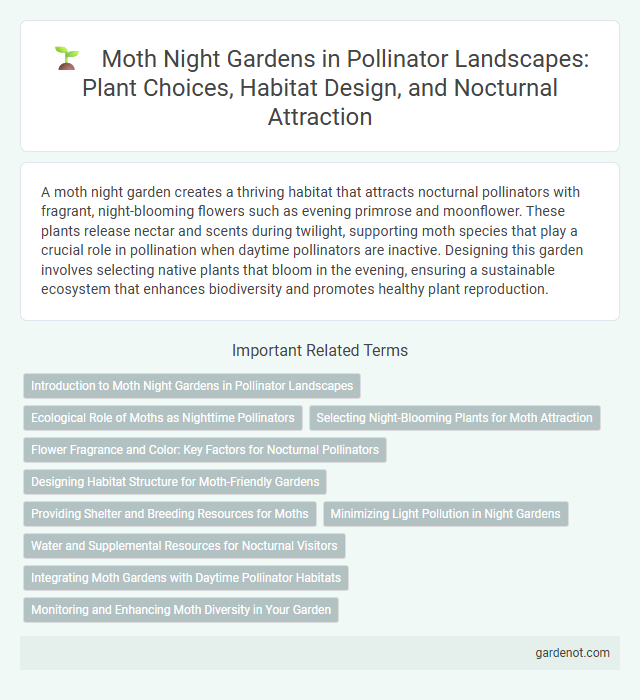A moth night garden creates a thriving habitat that attracts nocturnal pollinators with fragrant, night-blooming flowers such as evening primrose and moonflower. These plants release nectar and scents during twilight, supporting moth species that play a crucial role in pollination when daytime pollinators are inactive. Designing this garden involves selecting native plants that bloom in the evening, ensuring a sustainable ecosystem that enhances biodiversity and promotes healthy plant reproduction.
Introduction to Moth Night Gardens in Pollinator Landscapes
Moth night gardens play a vital role in pollinator landscapes by providing essential nocturnal habitats and food sources for moth species, which are crucial pollinators for many night-blooming plants. These gardens typically feature native night-blooming flowers such as evening primrose, moonflower, and nicotiana, attracting diverse moth populations and enhancing local biodiversity. Integrating moth night gardens supports ecosystem health by promoting pollination services and offering shelters for moths and other nocturnal insects.
Ecological Role of Moths as Nighttime Pollinators
Moths serve as essential nighttime pollinators, transferring pollen between nocturnal flowers that other pollinators overlook. Their activity enhances plant reproduction and biodiversity by supporting species that rely specifically on nocturnal pollination. Incorporating moth-attracting plants into a pollinator garden promotes ecological balance and sustains vital nighttime pollination networks.
Selecting Night-Blooming Plants for Moth Attraction
Choosing night-blooming plants such as evening primrose, moonflower, and night-blooming jasmine enhances a moth night garden by providing essential nectar sources after dusk. These plants emit strong fragrances and display pale or white hues, which improve visibility and attract nocturnal moth species. Incorporating diverse native night flowers supports local moth populations and promotes nighttime pollination.
Flower Fragrance and Color: Key Factors for Nocturnal Pollinators
Flower fragrance and color are critical factors in attracting nocturnal pollinators like moths to pollinator gardens. Many night-blooming flowers emit strong, sweet scents and exhibit pale or white hues that stand out in low light, enhancing visibility and scent detection for moths. These adaptive traits support effective nocturnal pollination, promoting biodiversity and ecosystem health.
Designing Habitat Structure for Moth-Friendly Gardens
Creating a moth night garden requires designing habitat structures that mimic natural environments, such as planting native flowering plants that bloom at night and providing sheltered areas like dense shrubs or leaf litter for moth resting. Incorporating light sources with low ultraviolet emissions helps attract moths without disrupting their natural behavior. Ensuring a diverse plant selection supports different moth species' larval food needs, promoting a healthy and thriving pollinator habitat.
Providing Shelter and Breeding Resources for Moths
Moth night gardens create essential habitats by incorporating dense shrubs and native plants that offer shelter for moths during daylight and adverse weather. Including host plants such as willow, oak, and nettle supports moth larvae by providing vital breeding resources and nourishment. Strategically placed leaf litter and logs further enhance the environment, fostering successful moth reproduction and population growth.
Minimizing Light Pollution in Night Gardens
Minimizing light pollution in moth night gardens preserves natural nocturnal habitats essential for moth pollinators. Using low-intensity, warm-colored LED lights and shielding fixtures reduces disruption to moth behavior and enhances pollination efficiency. Implementing dark zones and motion-activated lights further protects these beneficial insects while maintaining garden aesthetics.
Water and Supplemental Resources for Nocturnal Visitors
Moth night gardens thrive by providing a steady water source such as shallow dishes with stones to prevent drowning, ensuring nocturnal pollinators stay hydrated. Supplemental resources like native night-blooming flowers rich in nectar support moths' energy requirements during their active hours. Incorporating these elements enhances habitat suitability and promotes biodiversity among nighttime pollinators.
Integrating Moth Gardens with Daytime Pollinator Habitats
Moth night gardens enhance biodiversity by complementing daytime pollinator habitats such as butterfly and bee gardens, creating a continuous pollination network from dusk to dawn. Incorporating native night-blooming plants like evening primrose and night-blooming jasmine provides essential nectar sources for nocturnal moth species, boosting pollination efficiency and ecosystem health. This integration supports diverse pollinator communities, improves plant reproductive success, and fosters a balanced, resilient garden ecosystem.
Monitoring and Enhancing Moth Diversity in Your Garden
Moth night gardens provide a unique opportunity to monitor and enhance moth diversity by attracting various nocturnal species with native flowering plants and light sources mimicking moonlight. Using UV or mercury vapor lights combined with white sheets aids in identifying and recording moth species, contributing valuable data to citizen science projects like the National Moth Recording Scheme. Planting night-blooming nectar-rich plants such as evening primrose, jasmine, and nicotiana supports moth populations and promotes biodiversity in your garden ecosystem.
Moth night garden Infographic

 gardenot.com
gardenot.com